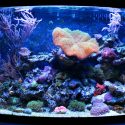How To Keep Live Plants In An Aquarium?
Growing live plants in the fish tank can be a fun hobby which will please both your pet and you. In addition to beautifying your living space, these things can bring many benefits. Just like other trees, they help increase the level of oxygen in the water and provide your fish with interesting spaces to play. Also, freshwater plants can help improve water quality and reduce algae growth by eliminating nitrates in the water.
If you are a novice and don’t know where to start, this post is for you. In the next sections, we’ll show some useful tips on how to keep live plants in an aquarium.
1. Install the lighting system
Every plant requires light to get nutrients and energy from photosynthesis. Thus, make sure to check the lighting requirements of your aquarium plants and install the right system. In general, LED lights and full-spectrum fluorescent can be both great choices. Also, natural light from the windows should also be utilised. In the beginning, it’s recommended to use no more than 2.5W for each gallon of water, which is the most common conditions for most freshwater plants.
2. Treat and quarantine new plants before growing them in the aquarium
Keep in mind that new plants might contain pests which could affect the existing conditions in your fish tank. Without checking methods, they can proliferate and fill your aquarium, or even bring in harmful bacteria. Thus, it’s advisable to quarantine these plants and find out any signs of pests. To resolve the issues, you can dip the plants in a bleach solution or saltwater in 4 or 5 minutes before rinsing off with clean water. Wait for at least one week before placing them in your aquarium.
3. Prune outgrown plants
Most freshwater plants might grow rapidly in their ideal conditions. Thus, make sure to prune them on a regular basis to prevent them the outside parts from decomposing. This can be done easily with sharp scissors in the kitchen. If you don’t have time for this maintenance task, then select slow-growing species for your aquarium.
4. Clean the water regularly
Aquarium plants don’t require water changes as regularly as fish, but cleaning at least once per week will keep the environment healthy and liveable. First, you need to remove a small amount of the water inside and eliminate all algae from the tank’s sides by scraping thoroughly. Pay special attention to these areas around the fixtures and gravel. Once it has completely cleaned, fill the tank with de-chlorinated, fresh water. If you worry about disrupting the ecosystem, consider installing some filters around to help get rid of harmful components.
5. Add fertiliser
If you have fish in the tank, they can boost the growth of your plants with their waste. Nevertheless, if you want these plants to grow better, it’s advisable to add some more fertiliser. Basically, you can fertilise your plants with one of the following techniques:
- Directly add fluorite to the substrate to provide nutrients and iron
- Add a liquid fertiliser to the aquarium at least once per week. This option is ideal for those plants which aren’t grown the substrate.
6. Add your fishes at the right time
Wait at least one week before adding your fish to the aquarium to ensure that the whole ecosystem has been fully established. This is known as the cycling process which makes water conditions stable and safe for living creatures. Adding fishes too early might lead to premature death. If you already have fish inside, consider leaving them into a temporary tank.
7. Add a substrate
A substrate is simply a material which covers the bottom of the aquarium to help grow your plants. As the plants grow, you need to install a nutrient-rich one, which can be a bit costlier. However, it can provide many necessary nutrients and add a touch of beauty to the existing environment.
Laterite and clay can be less expensive options. However, they might take more time to establish in the aquarium. Aqua soil also brings proper nutrients, but this product might reduce the level of pH in the water. Though this condition is good for plants, it might harm some of your fishes. Thus, make sure to check the pH needs before selecting this substrate.
That’s some useful tips that you can apply to keep your freshwater plants stay healthy in the aquarium. For more visual guides, check out the following clip:





